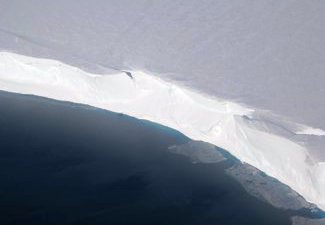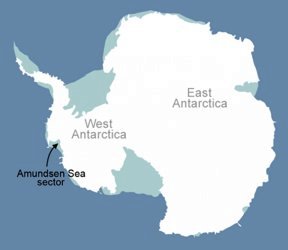
Irvine, California – Ocean waters melting the undersides of Antarctic ice shelves, not icebergs calving into the sea, are responsible for most of the continent’s ice loss, a study by UC Irvine and others has found.
The first comprehensive survey of all Antarctic ice shelves discovered that basal melt, or ice dissolving from underneath, accounted for 55 percent of shelf loss from 2003 to 2008 – a rate much higher than previously thought. Ice shelves, floating extensions of glaciers, fringe 75 percent of the vast, frozen continent.
The findings, published in the June 14 issue of Science, will help scientists improve projections of how Antarctica, which holds about 60 percent of the planet’s fresh water locked in its massive ice sheet, will respond to a warming ocean and contribute to sea level rise.
It turns out that the tug of seawaters just above the freezing point matters more than the breaking off of [ice]bergs.
“We find that iceberg calving is not the dominant process of ice removal. In fact, ice shelves mostly melt from the bottom before they even form icebergs,” said lead author Eric Rignot, a UC Irvine professor who’s also a researcher with NASA’s Jet Propulsion Laboratory in Pasadena. “This has profound implications for our understanding of interactions between Antarctica and climate change. It basically puts the Southern Ocean up front as the most significant control on the evolution of the polar ice sheet.”
Ice shelves grow through a combination of land ice flowing to the sea and snow falling on their surfaces. The researchers combined a regional snow accumulation model and a new map of Antarctica’s bedrock with ice shelf thickness, elevation and velocity data captured by Operation IceBridge – an ongoing NASA aerial survey of Greenland and the South Pole.
Ocean melting is distributed unevenly around the continent. The three giant ice shelves of Ross, Filchner and Ronne, which make up two-thirds of Antarctica’s ice shelves, accounted for only 15 percent of the melting. Meanwhile, less than a dozen small ice shelves floating on relatively warm waters produced half the total meltwater during the same period.
The researchers also compared the rates at which the ice shelves are shedding ice with the speed at which the continent itself is losing mass and found that, on average, the shelves lost mass twice as fast as the Antarctic ice sheet did.
“Ice shelf melt can be compensated by ice flow from the continent,” Rignot said. “But in a number of places around Antarctica, they are melting too fast, and as a consequence, glaciers and the entire continent are changing.”
Other authors are Jeremie Mouginot and Bernd Scheuchl of UC Irvine and Stanley Jacobs of Columbia University. Funding was provided by NASA, the National Science Foundation (NSF), and the National Oceanic & Atmospheric Administration (NOAA).
Check the following link to read/download the Full Study – “Ice Shelf Melting Around Antarctica”:
http://www.sciencemag.org/content/early/2013/06/12/science.1235798.abstract
Source: University of California – Irvine.


















